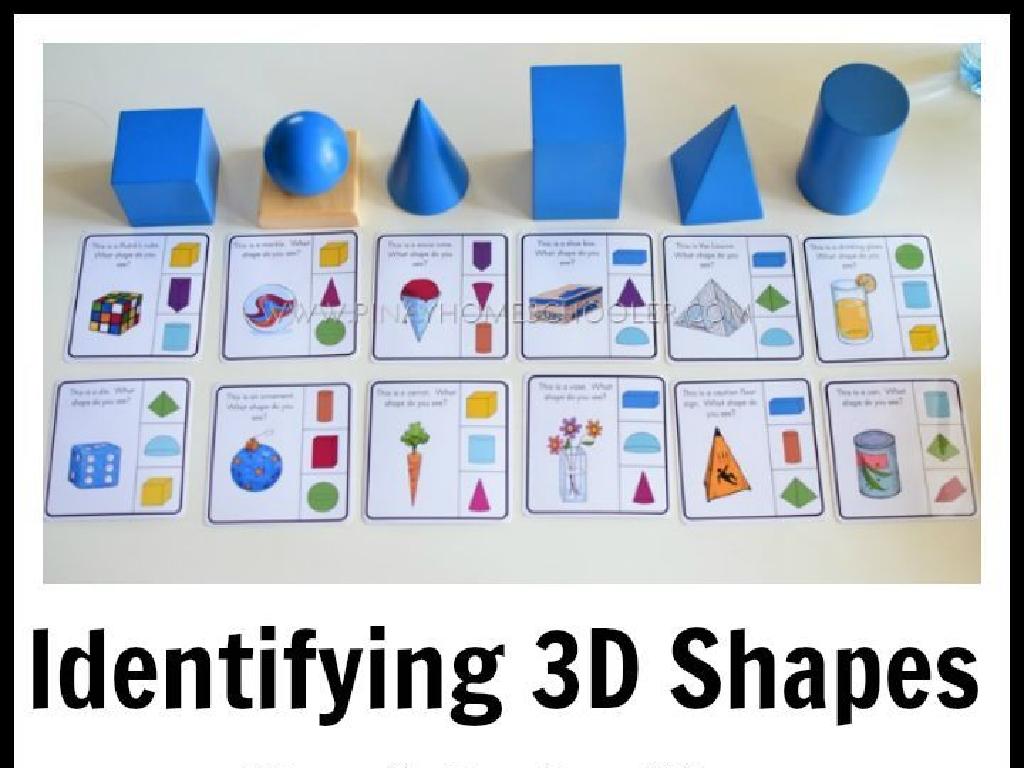Identify Trends With Scatter Plots
Subject: Math
Grade: Eighth grade
Topic: Two-Variable Statistics
Please LOG IN to download the presentation. Access is available to registered users only.
View More Content
Understanding Scatter Plots
– What is a scatter plot?
– A graph with points plotted to show a possible relationship between two sets of data.
– Visualizing data trends
– Points create a trend that can indicate a positive, negative, or no correlation.
– Scatter plots in the real world
– Used in various fields like economics, health, and meteorology to analyze data.
– Interpreting scatter plot patterns
– Recognize patterns such as clusters, gaps, or outliers that tell a story about the data.
|
This slide introduces students to the concept of scatter plots as a tool in two-variable statistics. Begin by defining a scatter plot and discussing its purpose in displaying the relationship between two different variables. Explain how trends are identified by the direction of the data points, whether they’re going upwards, downwards, or showing no particular pattern. Provide real-life examples where scatter plots are used, such as predicting economic trends, tracking health-related data, or weather forecasting. Teach students how to interpret different patterns in scatter plots, such as clusters of points that may indicate a strong relationship or outliers that deviate from the overall pattern. Encourage students to think critically about what these patterns might mean in a real-world context.
Understanding Scatter Plots
– Define a scatter plot
– A graph showing the relationship between two variables by displaying points.
– Scatter plot vs other graphs
– Unlike bar or line graphs, scatter plots show individual data points instead of totals or averages.
– Scatter plot components
– X-axis and Y-axis represent the variables; data points show values for each pair of variables.
– Interpreting data points
|
A scatter plot is a type of graph used to represent the relationship between two different variables, plotted along two axes, allowing us to see patterns or trends. It’s important to distinguish scatter plots from other graph types like bar graphs, which compare quantities, or line graphs, which show changes over time. A scatter plot’s main components are the X-axis (horizontal), Y-axis (vertical), and the data points that represent the values of the two variables. When interpreting scatter plots, students should look for clusters, outliers, and general directions that the data points seem to follow, which can indicate trends or correlations. This slide will set the foundation for understanding how scatter plots are constructed and interpreted in the context of two-variable statistics.
Understanding Scatter Plots
– Plotting ordered pairs
– Each pair (x, y) represents a data point on the graph
– Class test scores vs. study hours
– Example: (2 hours, 70%) vs. (5 hours, 85%)
– Interpreting data points
– Analyze the pattern formed by points to understand the relationship
– Recognizing data trends
– Look for upward, downward, or no trend to infer correlation
|
This slide introduces students to the concept of scatter plots as a tool for identifying trends in two-variable statistics. Begin by explaining how to plot ordered pairs (x, y) on a scatter plot. Use a relatable example, such as plotting class test scores against the number of hours studied, to demonstrate how each student’s data is represented on the graph. Guide students on how to interpret the plotted points by looking for patterns or trends, such as positive or negative correlations, or no correlation at all. Emphasize the importance of scatter plots in revealing relationships between variables in a visual and intuitive manner. Encourage students to practice plotting with additional examples and to discuss their observations of the data trends.
Identifying Trends in Scatter Plots
– Define scatter plot trend
– A trend shows the direction of data points in a scatter plot.
– Types of correlation
– Positive: upwards slope, Negative: downwards, No: scattered.
– How to draw trend lines
– Use a ruler to draw a line that best fits the data.
– Interpreting trend lines
– Trend lines help predict future data points.
|
This slide introduces students to the concept of trends in scatter plots, an important aspect of two-variable statistics. A trend in a scatter plot indicates the general direction in which a group of data points is moving. Students should learn to identify positive, negative, and no correlation trends. Positive correlation means as one variable increases, so does the other. Negative correlation is the opposite, and no correlation means there is no clear pattern. Drawing trend lines involves plotting a straight line that best represents the data points on the scatter plot. This line can then be used to make predictions about future data. Encourage students to practice by identifying the type of correlation and drawing trend lines on different scatter plots.
Correlation vs. Causation in Scatter Plots
– Difference between correlation and causation
– Correlation implies a relationship, causation implies one causes the other.
– Examples where correlation is not causation
– Ice cream sales and shark attacks increase together, but one does not cause the other.
– Avoiding hasty conclusions
– Critical thinking in statistics
– Understanding this concept prevents misinterpretation of data.
|
This slide aims to clarify the often misunderstood concepts of correlation and causation, especially as they appear in scatter plots. Correlation refers to a statistical relationship between two variables, whereas causation implies that one variable actually causes the other to occur. Provide students with vivid examples where two things may seem related but are not causally linked, such as the classic example of ice cream sales and shark attacks. Emphasize the importance of not jumping to conclusions without further investigation, and encourage students to think critically about the data presented in scatter plots. This understanding is crucial for their future studies in statistics and for making informed decisions based on data.
Analyzing Scatter Plots
– Identify clusters in scatter plots
– Clusters are groups of points close together.
– Recognize outliers in data
– Outliers are points that lie far from others.
– Interpret clusters and outliers
– Clusters show trends; outliers may indicate errors or exceptions.
– Activity: Spot the outlier
|
This slide introduces students to the concepts of clusters and outliers within scatter plots. Clusters in scatter plots indicate where data points are concentrated and can reveal trends or patterns in the data. Outliers are points that are distant from others and can suggest unique cases or possible errors in data collection. Understanding these elements is crucial for interpreting real-world data. The activity involves students analyzing a provided scatter plot to find any outliers. This hands-on approach will help solidify their understanding of the concepts. For the activity, prepare several scatter plots with varying degrees of clustering and outliers to accommodate different student skill levels.
Scatter Plots in the Real World
– Scatter plots in various fields
– Example: Weather, sports, economics
– Weather: Temperature vs. Humidity, Sports: Scores vs. Training, Economics: Income vs. Spending
– Interpreting data with scatter plots
– Use plots to make predictions, see relationships
– Recognizing patterns and trends
– Look for clusters, gaps, or outliers
|
This slide aims to show students the practical application of scatter plots in different fields. Scatter plots are valuable tools for visualizing the relationship between two variables. For instance, meteorologists use them to correlate temperature and humidity, sports analysts to compare scores and training hours, and economists to examine income versus spending habits. By interpreting scatter plots, students can learn to predict trends, identify correlations, and recognize patterns such as clusters, gaps, or outliers in real-world data. Encourage students to think critically about how these visual representations provide insights that can influence decisions in various industries.
Class Activity: Creating Our Scatter Plot
– Gather data with a partner
– Plot artist popularity over time
– Use a graph to map popularity against time
– Analyze trends in your scatter plot
– Look for patterns or correlations in the data
– Present findings to the class
|
In this interactive class activity, students will work in pairs to collect data on a favorite music artist’s popularity over time, perhaps using metrics like number of album sales, Spotify listeners, or social media followers each year. They will then plot this data on a scatter plot to visualize any trends. Encourage students to discuss what they see whether the artist’s popularity is increasing, decreasing, or staying the same over time. After analyzing their scatter plot, each pair will present their findings to the class, explaining the trend they’ve identified. This exercise will help students understand how scatter plots can be used to identify trends in real-world data. Provide guidance on how to create a scatter plot and how to interpret the results. Possible activities for different pairs could include comparing different artists or different time periods.
Scatter Plots: Recap and Q&A
– Recap: What are scatter plots?
– Visual representation of data points on a graph.
– Understanding trends in data
– Look for patterns: upward, downward, or no trend.
– Scatter plots’ role in statistics
– They help us see correlations between variables.
– Open floor for questions
|
This slide aims to summarize the key points about scatter plots and their importance in understanding data trends. Begin by recapping what a scatter plot is and how it is used to represent two variables on a graph. Emphasize the ability to identify different types of trends such as positive, negative, or no correlation. Discuss the significance of scatter plots in real-world statistics, such as predicting outcomes and making informed decisions. Finally, encourage students to ask questions or express any confusion they might have, ensuring they leave the class with a solid understanding of the topic. Prepare to address common misconceptions and provide additional examples if necessary.





